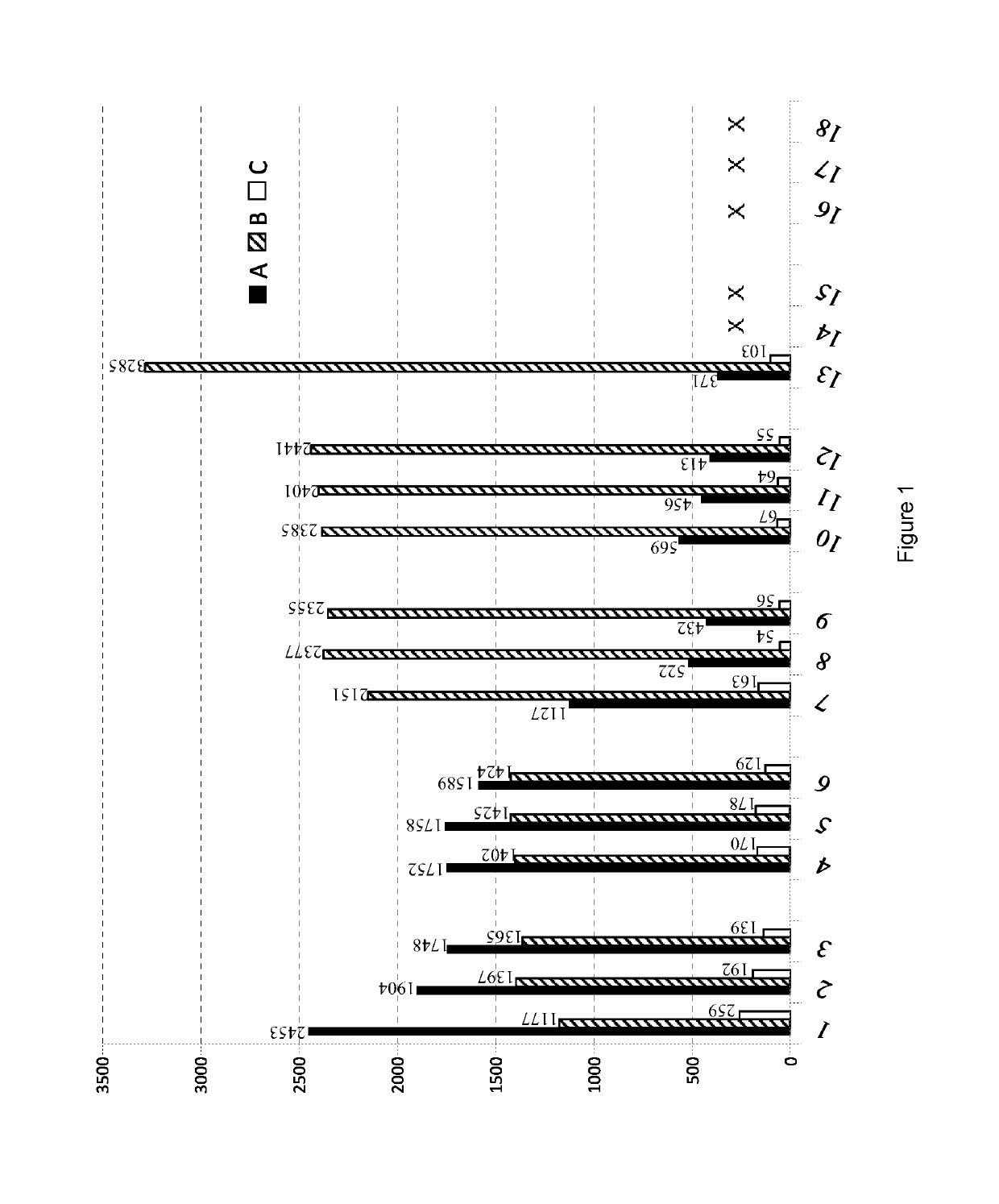Man-made cellulosic fiber and nonwoven product or fabric comprising the cellulosic fiber
a cellulosic fiber and man-made technology, applied in the field of man-made modified cellulosic fibers, can solve the problems of insufficient binding strength between anionic fibers alone, inability to wash, and inability to add cationic polyelectrolytes
- Summary
- Abstract
- Description
- Claims
- Application Information
AI Technical Summary
Benefits of technology
Problems solved by technology
Method used
Image
Examples
example 1
Material Used:
[0069]Reference fiber:[0070]Viscose fiber Danufil® 0.9 dtex / 6 mm (Fiber 1.1)[0071]Anionic viscose fiber:[0072]Viscose fiber with CMC-Incorporation and 2.4 wt. % COOH (see WO 2011 / 012423A1) was produced in 0.9 dtex / 6 mm (Fiber 1.2)[0073]PAM-DADMAC:[0074]Poly(acrylamide-co-diallyldimethylammonium chloride) (PAM-DADMAC), 98%[0075]CAS: 26590-05-6[0076]Molecular weight: 105 g / mol[0077]55 wt. % Acrylamide[0078](Sigma-Aldrich Chemie GmbH, Taufkirchen)
Procedure:
Production of Fibers:
[0079]200 g of Fiber 1.2 were added to 2 liters of a 1 wt. % PAM-DADMAC solution in H2O and stirred for 5 minutes.
[0080]The fibers were filtered off and the remaining liquid was squeezed out, until a total weight of 800 g was reached. The fiber was then washed with deionized water and squeezed out again.
[0081]The fiber prepared by this procedure (Fiber 1.3) was analyzed to have a nitrogen content of 0.89 wt. % which corresponds to a level of 6 wt. % PAM-DADMAC on fiber.
Test Paper Production:
[0082]Th...
example 2
Material Used:
[0095]Anionic viscose fiber:
[0096]Anionic viscose fibers were produced in 1.3 dtex / 6 mm (see WO 2011 / 012423A1) with different percentages of CMC incorporation. The grade of CMC incorporation was characterized by the percentage of carboxylic groups in the fiber.[0097]Fiber 2.1: 1.3 wt. % COOH[0098]Fiber 2.2: 1.7 wt. % COOH[0099]Fiber 2.3: 2.3 wt. % COOH[0100]PAM-DADMAC:[0101]Poly(acrylamide-co-diallyldimethylammonium chloride) (PAM-DADMAC), 98%[0102]CAS: 26590-05-6[0103]Molecular weight: 105 g / mol[0104]55 wt. % Acrylamide[0105](Sigma-Aldrich Chemie GmbH, Taufkirchen)
Procedure:
Production of Fibers:
[0106]The fibers were treated with polyelectrolyte in a bath procedure analogous to Example 1. Different levels of polyelectrolyte were set by using different bath concentrations.
[0107]The add-on level of polyelectrolyte on the fibers was determined by nitrogen analysis on the produced test paper sheets.
PolyelectrolyteFiber IDwt. % COOHPolyelectrolyteon fiber wt. %Fiber 2.1.11....
example 3
Material Used:
[0115]Anionic viscose fiber:[0116]Fiber 2.3 from Example 2[0117]Cationic viscose fiber:[0118]Danufil® DeepDye 1.7 dtex / 5 mm (Kelheim Fibers GmbH, Kelheim)[0119]Non ionic (regular) viscose fiber:[0120]Danufil® 1.7 dtex / 5 mm (Kelheim Fibers GmbH, Kelheim)[0121]PAM-DADMAC:[0122]Poly(acrylamide-co-diallyldimethylammonium chloride) (PAM-DADMAC), 98%[0123]CAS: 26590-05-6[0124]Molecular weight: 105 g / mol[0125]55 wt. % Acrylamide[0126](Sigma-Aldrich Chemie GmbH, Taufkirchen)
Procedure:
[0127]The fibers were treated with polyelectrolyte in a bath procedure analogous to Example 1. Different levels of polyelectrolyte were set by using different bath concentrations.
Test Paper Production:
[0128]The paper was produced in a Rapid Köthen Lab sheet former. The test paper sheets with 30 g / m2 were dried in an oven at 105° C. without any pressure load.
[0129]Test results are depicted in Fig.1 and show that only the combination of anionic fiber with cationic polyelectrolyte gives a significant...
PUM
| Property | Measurement | Unit |
|---|---|---|
| molar ratio | aaaaa | aaaaa |
| length | aaaaa | aaaaa |
| length | aaaaa | aaaaa |
Abstract
Description
Claims
Application Information
 Login to View More
Login to View More - R&D
- Intellectual Property
- Life Sciences
- Materials
- Tech Scout
- Unparalleled Data Quality
- Higher Quality Content
- 60% Fewer Hallucinations
Browse by: Latest US Patents, China's latest patents, Technical Efficacy Thesaurus, Application Domain, Technology Topic, Popular Technical Reports.
© 2025 PatSnap. All rights reserved.Legal|Privacy policy|Modern Slavery Act Transparency Statement|Sitemap|About US| Contact US: help@patsnap.com

